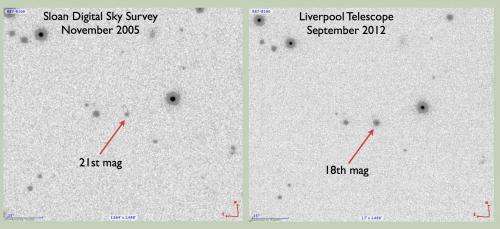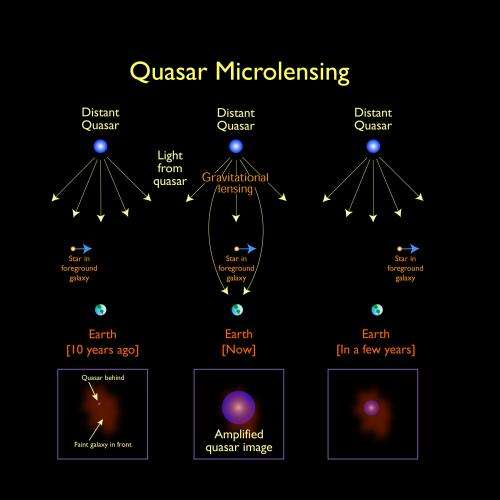Intergalactic magnifying glasses could help astronomers map galaxy centres

(Phys.org) —An international team of astronomers may have found a new way to map quasars, the energetic and luminous central regions typically found in distant galaxies. Team leader Prof. Andy Lawrence of the Royal Observatory Edinburgh presents the new results on Monday 1 July at the RAS National Astronomy Meeting in St Andrews, Scotland.
If a star passes too close to a giant black hole found in the centre of a galaxy, it will be shredded by the strong gravitational field. This should produce a flare-up in the brightness of an otherwise normal looking galaxy that then fades over a few months. In a large scale survey Prof. Lawrence and his team studied galaxies to search for this effect, finding flare-ups but with very different behaviour to predictions.
Instead of seeing a fade over months, the objects they found look like 'normal' quasars, regions in the centre of galaxies where material is swirling around a giant black hole in a disk. The quasars in the survey were not seen a decade ago, so must be at least ten times brighter than before. They are also changing slowly, fading over a timescale of years rather than months.
The biggest surprise however was that the quasars seemed to be at the wrong distance. Measuring the characteristic shift in lines found in the spectrum of the quasars allows astronomers to measure the speed at which they are moving away from the Earth. Knowing the way in which the universe is expanding enables scientists to deduce the distance to each object.

In the new survey, the quasars are typically around 8 billion light years away, whereas the galaxies that host them are 3.4 billion light years distant. It could be that the estimated galaxy distances are wrong and that the black holes in the centre of the galaxies have flared up dramatically. But past studies of thousands of well known quasars have never shown events on this scale.
If however the estimated galaxy distances are right, then Prof. Lawrence and his team believe they are looking at a distant quasar through a foreground galaxy. Normally this has little effect on the light of the quasar, but if a single star in the foreground galaxy passes exactly in front of the quasar, it can produce a gravitational focusing of the light which makes the background quasar seem temporarily much brighter.
This "microlensing" phenomenon is well known inside our own Galaxy, producing a brightening when one star passes in front of another. (It is for example also now being used to detect exoplanets). Microlensing may also be the cause of low-level "flickering" seen in some quasars. But this is the first time it has been suggested to cause such giant brightening events.
Prof. Lawrence sees real potential in this newly-discovered effect. "This could give us a way to map out the internal structure of quasars in a way that is otherwise impossible, because quasars are so small. As the star moves across the face of the distant quasar, it is like scanning a magnifying glass across it, revealing details that would otherwise simply be impossible to detect."
Provided by Royal Astronomical Society


















